Learn how to translate video from Spanish to English quickly with our AI-powered guide. Perfect for accurate, hassle-free translations. Click to discover more!
In This Article
Subscribe to our newsletter
If your content is in Spanish, translating it into English is probably the single biggest lever you can pull to grow your audience. This isn't just about subtitles anymore. With the right AI tools, you can create fully localized English versions of your videos—and it's now incredibly fast, affordable, and accessible for creators of all sizes.
Why Translate Your Spanish Videos to English
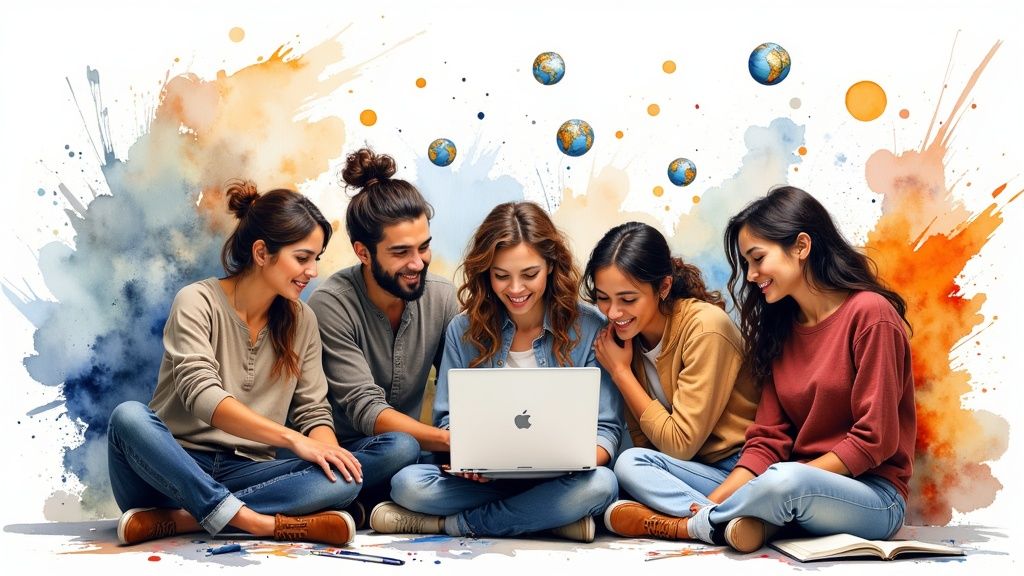
Thinking about translating your videos from Spanish to English is a strategic business decision, not just a content tweak. It's about taking what you've created for a specific market and opening it up to the entire world.
Imagine a Spanish e-learning platform that wants to attract students from the US, UK, and Australia. A simple translation instantly unlocks those massive, lucrative markets. Or think about a Latin American brand—by creating English versions of their marketing videos, they can compete in North America, build credibility, and find a whole new customer base.
The potential for growth is staggering. You’re essentially transforming a regional asset into a global one.
Unlocking New Audiences and Revenue
The English-speaking online market is one of the largest and most active on the planet. If you're not offering an English version of your video, you're unintentionally shutting the door on a massive segment of your potential audience. This isn't just about getting more views; it's about real, tangible revenue.
The benefits are direct and powerful:
- Increased Monetization: More views on platforms like YouTube mean more ad revenue. It's that simple.
- Global E-commerce Sales: Product demos or explainer videos in English can drive sales from customers who otherwise would have never even found your brand.
- Wider Educational Reach: Course creators can sell their programs to a global student body that is constantly looking for high-quality educational content.
By making your content accessible, you're not just translating words; you're translating value. An English version of your video signals to a global audience that your brand is professional, inclusive, and ready for international business.
Manual vs AI Translation At a Glance
So, how do you get it done? While manual translation has its place, AI-powered tools have changed the game for most video creators. Here's a quick comparison showing why AI is often the smarter choice.
| Feature | Manual Translation | AI-Powered Translation |
|---|---|---|
| Speed | Slow; can take days or weeks for a single video. | Extremely fast; often just a matter of minutes. |
| Cost | High; involves hiring professional translators. | Very affordable; subscription-based models. |
| Scalability | Difficult to scale; limited by human resources. | Highly scalable; translate entire libraries easily. |
| Consistency | Can vary between different translators. | Perfectly consistent terminology and tone. |
| Accessibility | Requires finding and managing skilled talent. | Accessible to anyone with an internet connection. |
For creators who need to move fast and publish consistently, the speed and cost-effectiveness of AI translation are hard to beat.
The Growing Demand for Translated Content
This isn't just a hunch; it's a major market shift. The demand for localized video content is exploding. The global video translation market was valued at a whopping USD 1.7 billion in 2024 and is on track to hit USD 4.5 billion by 2033. That number alone shows how much value businesses are placing on speaking their customers' language.
This growth is all about viewer expectations. People prefer to watch content in their native tongue, and tools like Aeon have made it ridiculously easy for creators to meet that demand.
If you want to dig deeper, our guide on how video subtitles translation can boost your global reach is a great next step. By jumping on this now, you’re positioning your content to meet a demand that's only going to get bigger.
Laying the Groundwork for a Flawless Translation
Before you even think about translating a Spanish video into English, you need to do a little prep work. It's a lot like cooking—the final dish is only ever as good as the ingredients you start with. When it comes to AI translation, your most important ingredient, by far, is the audio from your original video.
Let's be blunt: clear, crisp audio is non-negotiable. If your Spanish audio track is full of muffled dialogue, distracting background noise, or people talking over each other, the AI is going to have a rough time creating an accurate transcript. That one initial error will then snowball, affecting the entire translation and leaving you with a flawed final product. Do yourself a favor and listen to the audio with a good pair of headphones first. You'll quickly spot any potential red flags.
Get Your Media Files in Order
Once you're confident in your audio quality, it’s time to get organized. A project can go off the rails fast when you're digging through a messy desktop for the right file. I've learned that a simple, consistent file naming system is a massive time-saver.
Instead of vague names, try a format like this:
- Original Video:
Video-Name_ES_Original.mp4 - English Version:
Video-Name_EN_Translated.mp4
This little habit makes it incredibly easy to find what you need, especially when you're juggling multiple videos or languages.
It also goes without saying, but always start with the highest-quality video file available. Over-compressing a video can degrade the audio, which brings us right back to our most important rule. A high-resolution source file doesn't just help the AI; it ensures your final translated version looks polished and professional.
Key Takeaway: The success of your entire translation project hinges on the quality of your initial audio. Garbage in, garbage out is the golden rule here. A clean audio track is the foundation for an accurate transcript and, subsequently, a natural-sounding English translation.
Finally, think about accessibility from the very beginning. Great subtitles aren’t just about getting the words right; they also need to be readable and perfectly timed. To make sure your translated video works for everyone, it helps to be familiar with the WCAG Captioning Standards for Video Content. Knowing these guidelines provides a solid framework for creating captions that are truly effective. This kind of foresight ensures your content isn't just translated, but is genuinely accessible to all viewers.
Generate a Precise Spanish Transcript with AI
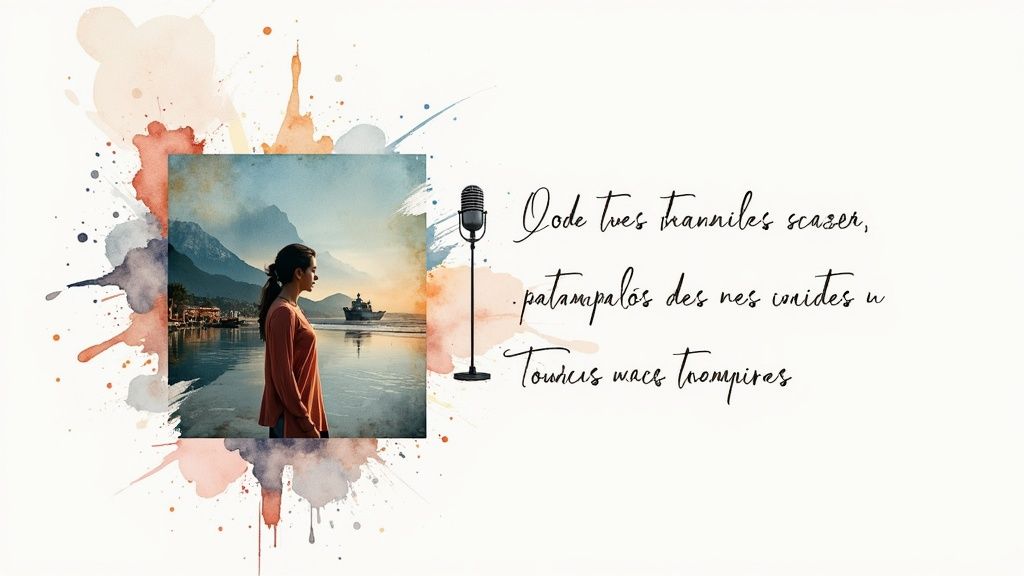
Every great video translation starts with one thing: a rock-solid transcript of the original audio. This is your foundation. If it's shaky, the entire English version will be, too.
Luckily, this is where AI does the heavy lifting for you.
With a platform like Aeon, you just upload your Spanish video and let the AI listen, process, and spit out a text version of the dialogue. What used to take hours of painstaking manual work now gets done in a matter of minutes. The initial draft is usually shockingly good, capturing most of the conversation with incredible accuracy.
For those new to this, it's worth understanding AI features in general, as it helps you get the most out of these tools.
This kind of automation is a game-changer, powered by massive leaps in machine learning. The global machine translation market hit over USD 1.1 billion in 2022 and is still climbing, which means the tools are only getting better and making it possible to translate video from Spanish to English at a scale we've never seen before.
Polishing the AI-Generated Transcript
Even the smartest AI can get tripped up by nuances, especially with regional dialects or speakers who talk a mile a minute. That's why the next move is a quick, but vital, review of the Spanish transcript. You’re not transcribing from scratch—you’re just proofreading.
Think of it as running a spell-check on your audio. As you read the text while listening to the video, you’ll easily catch and fix any small mistakes.
- Catching Regionalisms: Did the speaker use a specific Mexican slang term like "qué padre"? Make sure the AI wrote it down correctly. This detail is crucial for getting the cultural context right in the final translation.
- Fixing Punctuation: AI sometimes struggles with the natural cadence of a conversation. Adding a few commas and periods where they belong makes the text flow better and helps the translation AI understand sentence structure.
- Correcting Proper Nouns: Always double-check the spelling of names, places, or brands. These are the kinds of specific details an AI might not recognize.
Pro Tip: Play the video at 1.5x speed while you review. It’s a neat trick that helps your brain spot mismatches between the audio and the text much faster. You can turn a 10-minute review into a quick 6-minute job.
This quick once-over ensures your source text is absolutely perfect. This is also a fundamental step for creating accurate captions, which are a must for accessibility. For more on that, check out our guide on how to enhance engagement with a video caption maker.
With a flawless Spanish transcript locked in, you’re all set for the main event: the translation itself.
Translate Your Transcript From Spanish to English
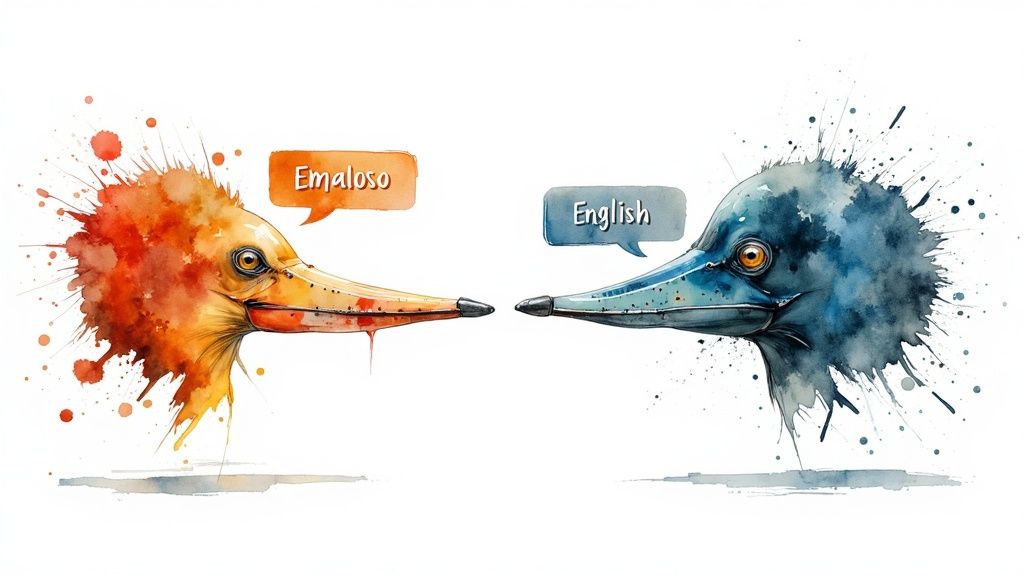
Alright, with your polished Spanish transcript in hand, we're ready for the translation. This is where AI really flexes its muscles, moving way beyond those clunky, literal translations that just sound… off. Modern AI models are sophisticated enough to grasp the intent, tone, and even the cultural quirks behind the original dialogue.
This is a game-changer. A basic word-for-word translation can completely gut the personality from your content, making it feel sterile and alien to a new audience. Good AI, however, works to create an English script that feels like it was written by a native speaker from the get-go.
This is especially true when localizing from Spanish to English. There's a huge and growing demand for Spanish-language content in the U.S., and it's a market you can't afford to ignore. In fact, over 30% of online media consumption in the country is from bilingual Spanish-English speakers who expect authentic, natural communication. If you want to dive deeper into this trend, MotionPoint has some fantastic insights.
Beyond Literal Translation: Idioms and Nuance
A smart AI translator knows that language is so much more than a collection of words; it’s about conveying meaning. Idioms are the perfect acid test for this.
Let's take a common Spanish phrase: "no tener pelos en la lengua."
A literal, machine-like translation would spit out "to not have hairs on the tongue," which means absolutely nothing in English. It’s just gibberish.
A context-aware AI, on the other hand, instantly flags this as an idiom. It understands the meaning is to speak bluntly or without hesitation. So, it will find a natural English equivalent that captures the original spirit.
Here’s how a good AI might handle it:
- "To be very blunt."
- "To not mince words."
- "To be brutally honest."
This knack for localizing expressions is what separates a decent translation from a professional one. The AI isn't just swapping words; it’s transferring the same feeling and idea to a new audience. This is absolutely critical when you translate a video from Spanish to English.
Conducting a Quick Sense Check
Once the AI has worked its magic and you have the English transcript, it's time for the final, crucial human touch: a quick "sense check." You don't need to be a professional linguist for this. You're simply reading through the English text to make sure it flows well and sounds like something a real person would say.
Your goal is to spot anything that feels awkward or out of place. Ask yourself, "Would a native English speaker actually say it this way?" This simple question is your most powerful quality control tool.
As you scan the text, keep an eye out for these things:
- Natural Phrasing: Does the sentence structure feel natural? Sometimes an AI translation is grammatically perfect but sounds a bit too formal or stiff.
- Consistent Tone: Does the translated text match the vibe of the original video? If your video is laid-back and conversational, the English script should be too.
- Contextual Accuracy: Does the dialogue make sense with what's happening on screen? A quick read-through ensures the words align with the visuals.
This final review is usually pretty quick, but it's an indispensable step. It's the difference between a video that is simply understood and one that genuinely resonates with your new English-speaking viewers, making your content feel truly global.
Alright, your English transcript is polished and ready to go. Now comes the interesting part: how do you want your new audience to hear it?
This is where you decide between two fantastic options: a surprisingly realistic AI voice clone or crisp, perfectly timed subtitles.
Neither one is flat-out better than the other. The best choice really boils down to your video's style, who you're trying to reach, and what you want them to take away from it.
What’s the Deal with AI Voice Cloning?
AI voice cloning is some seriously impressive tech. It listens to the original Spanish speaker's voice—all the unique quirks in their pitch, tone, and pacing—and uses that to generate the new English audio.
The result? It sounds almost exactly like the original person is speaking fluent English.
This creates a super smooth, immersive experience. If you’re making product tutorials, corporate training videos, or documentaries, a voice clone is almost always the way to go. Your viewers can stay glued to the visuals without having to read along, which makes complex information much easier to digest. It also keeps your brand's "voice" consistent.
If you want to dive deeper into this, we've got a great guide on the world of AI voice actors and synthetic voices that breaks it all down.
The Understated Power of Subtitles
On the flip side, subtitles offer a completely different, but equally powerful, way to connect with your audience.
They're the perfect choice when the original speaker's raw emotion is the star of the show. Think of intense interviews, personal vlogs, or anything with a bit of drama. Subtitles let your viewers hear every bit of passion or humor in the original Spanish, while still understanding the message perfectly.
Subtitles are also a non-negotiable for social media. A huge chunk of people scroll through feeds with the sound off, so having clear, easy-to-read text on screen means your message still lands. Plus, it makes your content accessible to viewers who are deaf or hard of hearing, which is a massive win.
To make the choice a little clearer, here’s a look at how they stack up in terms of production time and where they shine the brightest.
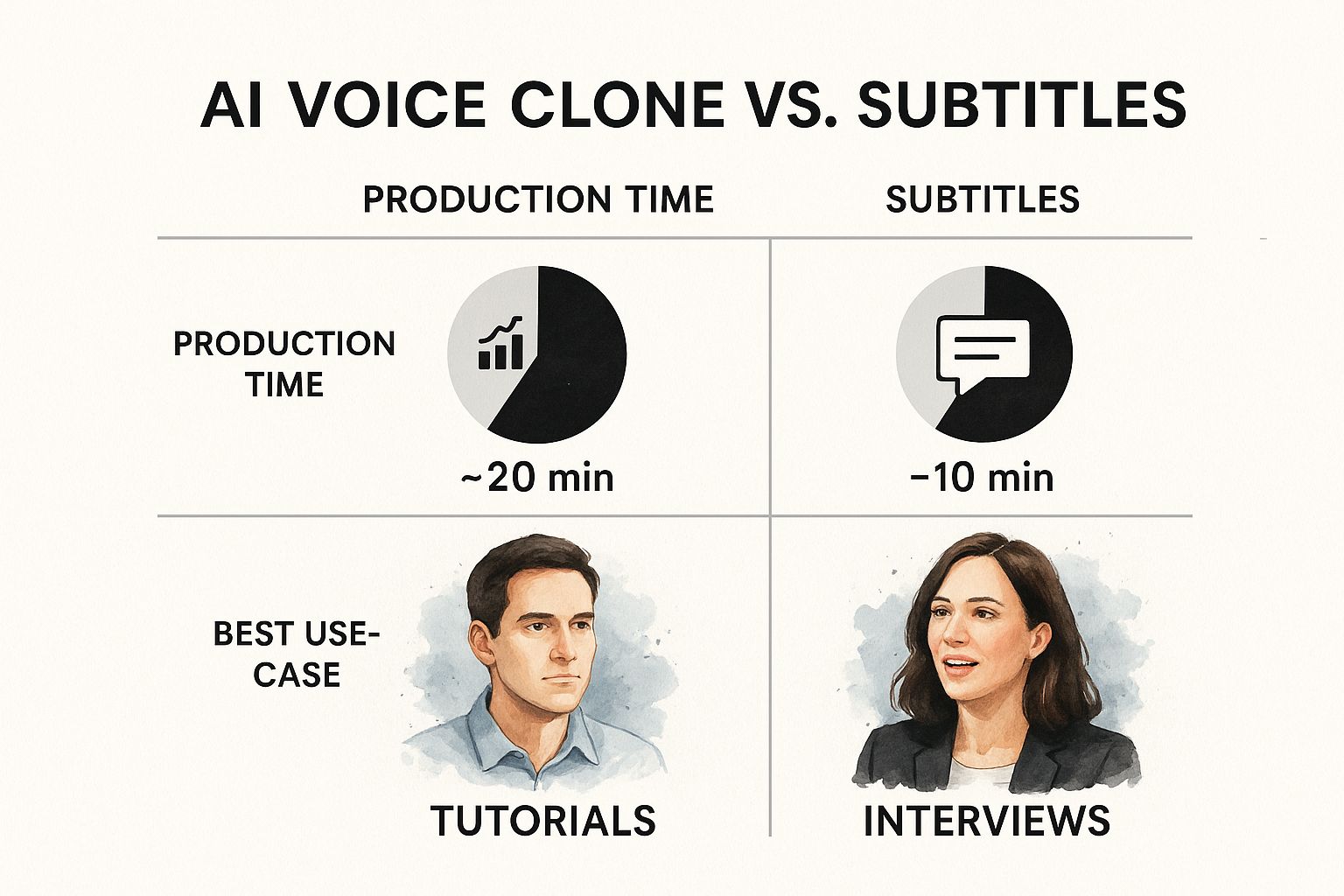
As you can see, subtitles are usually the faster option, but an AI voice clone delivers that seamless, "made-for-me" feeling that some content really needs.
Voiceover vs Subtitles Which is Right For Your Video?
Still on the fence? This table should help you weigh the pros and cons based on what you're trying to achieve.
| Consideration | AI Voiceover/Cloning | English Subtitles |
|---|---|---|
| Viewer Experience | Creates an immersive, "native" feel. Viewers can focus on visuals. | Allows the audience to hear the original speaker's tone and emotion. |
| Best Content Types | Tutorials, training videos, e-learning, documentaries, corporate explainers. | Interviews, vlogs, dramatic content, testimonials, artistic films. |
| Social Media | Less effective, as many users watch with sound off. | Highly effective. Captures attention even in silent-play environments. |
| Accessibility | Helps those with visual impairments but doesn't serve the deaf community. | Excellent for accessibility, reaching deaf and hard-of-hearing viewers. |
| Production Speed | Can take slightly longer due to processing and quality checks. | Generally faster to produce and implement once the transcript is ready. |
| Brand Consistency | Maintains the original speaker's "voice," reinforcing brand identity. | Puts the focus on the content's message over the speaker's specific voice. |
Ultimately, choosing to go with a voice clone or subtitles is a strategic call. Think about your audience, where they'll be watching, and the core purpose of your video.
Do you need them to absorb visual information without distraction? Go with a voice clone.
Is it all about raw emotion or grabbing scrollers on social media? Subtitles are your best bet. Answering that one question will point you directly to the right localization strategy for your project.
You’ve made it to the final stretch. All the heavy lifting is done, and now it’s time to add that final layer of polish. This is the quality control stage, and trust me, spending a few extra minutes here can make or break the final product.
The number one thing you’re looking for is synchronization. Whether you went with an AI voice clone or decided on subtitles, you need to watch the entire video from beginning to end.
Does the new English audio line up with the speaker’s lip movements? Do the subtitles appear and disappear in perfect harmony with the on-screen action? Even a tiny lag can make the whole thing feel off and unprofessional.
Fine-Tuning and Quality Checks
If you do spot a timing issue, don't worry. This is completely normal and easy to fix. Platforms like Aeon have an intuitive timeline editor built for exactly this purpose. You can simply grab a subtitle and nudge it a fraction of a second forward or backward until it feels right.
For AI voiceovers, listen for any unnatural pauses or rushed sentences. You can easily adjust the spacing between words or sentences to create a more natural, human-like rhythm.
Here’s a quick checklist I run through before every export:
- Audio-Visual Sync: Do the words match the speaker’s expressions and on-screen cues?
- Subtitle Readability: Are the subtitles on screen long enough for someone to actually read them without hitting pause?
- Audio Levels: Is the new English voiceover balanced correctly with any background music or sound effects? You don't want it to be drowned out or blaring over everything else.
A perfectly synchronized video feels seamless. The goal is for your audience to completely forget they’re watching a translated version. That level of polish is what turns good content into truly great content.
Choosing the Right Export Settings
Once you’re happy with the final review, it's time to export. The settings you choose here depend entirely on where the video will live. Every platform has its own preferred specs, and getting them right is crucial for quality.
Exporting for YouTube, for example, requires a different approach than prepping a short clip for TikTok.
- For YouTube or Websites: The gold standard is 1080p (1920x1080) resolution. Stick with the MP4 format using an H.264 codec—it gives you fantastic quality without a massive file size.
- For TikTok or Instagram Reels: You absolutely need a vertical aspect ratio, so go with 1080x1920. It’s also a good idea to choose a slightly lower bitrate to keep the file size down, which helps with faster uploads on mobile.
By tailoring these settings, you’re making sure your newly translated video looks crisp and professional, no matter where your new global audience finds it.
Got Questions? We've Got Answers
Just How Good Is AI at Translating Spanish to English Video?
People are often surprised by the accuracy of modern AI tools. With clear audio, you're looking at 95% accuracy or even higher. It's a two-step dance: first, an AI model transcribes the original Spanish dialogue into text. Then, another AI takes that text and translates it into English.
While the AI is fantastic with grammar and grasping the overall context, I always recommend a quick human once-over. It's that final polish that catches subtle cultural nuances or specific idioms, making sure the final product sounds like it was originally created in English.
Can the Translation Sound Like the Original Speaker?
Absolutely. This is where AI voice cloning comes in, and it's pretty impressive stuff. The technology listens to the original speaker's unique vocal patterns—their pitch, tone, and rhythm—and then generates the new English audio in a voice that's a dead ringer for theirs.
The result is a genuinely seamless viewing experience. It feels less like a translation and more like the original speaker is just naturally fluent in English, which does wonders for keeping that personal connection with your audience.
Should I Go With Subtitles or an AI Voiceover?
The classic question! Honestly, the right answer really hinges on your content and where your audience is watching.
An AI voiceover, especially a voice clone, is incredibly immersive. It’s the perfect fit for things like:
- Educational content
- Documentaries
- Product tutorials
Basically, anything where you want the viewer to stay locked on the visuals without being distracted by reading text.
Subtitles, however, are king on social media, where a ton of people watch videos with the sound off. They're also a great choice for interviews when you want to keep the raw emotion of the original speaker's voice intact. If you can, offering both is the ultimate move for making your content accessible to everyone.
Ready to see this in action with your own videos? Discover how Aeon makes it incredibly simple to take your content global. Start your project today.

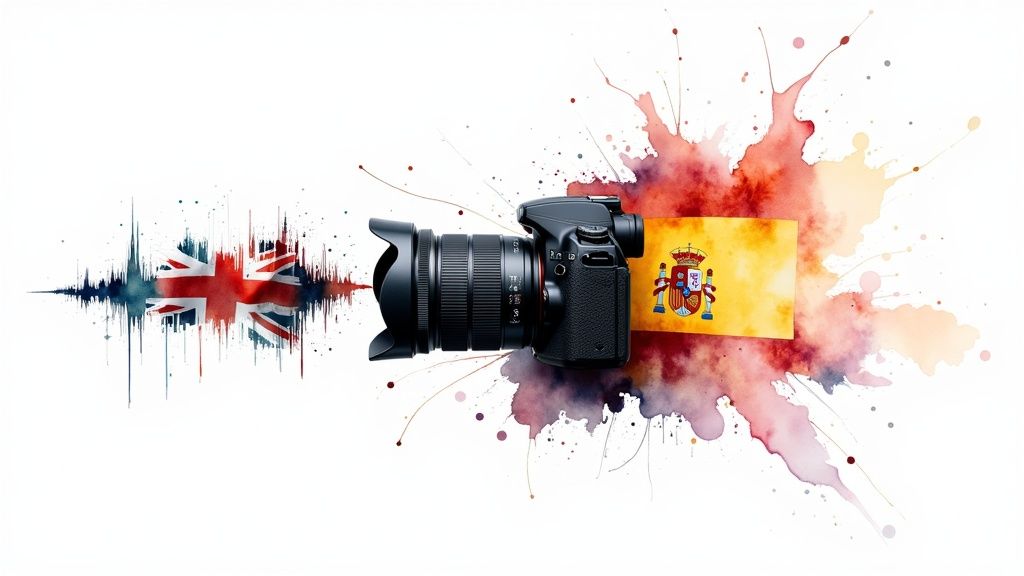
.jpg)